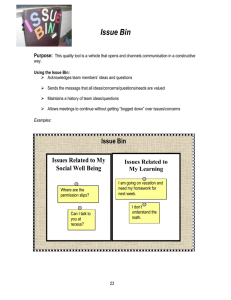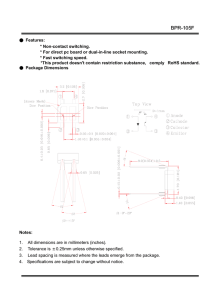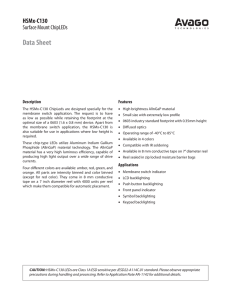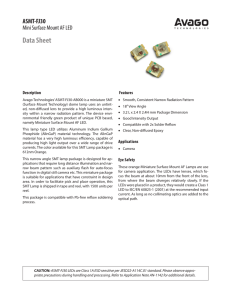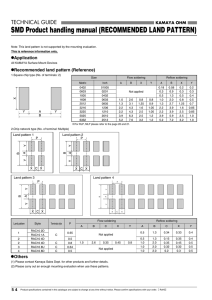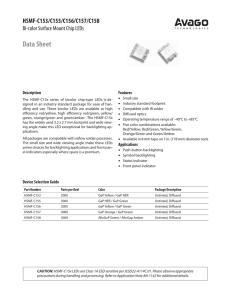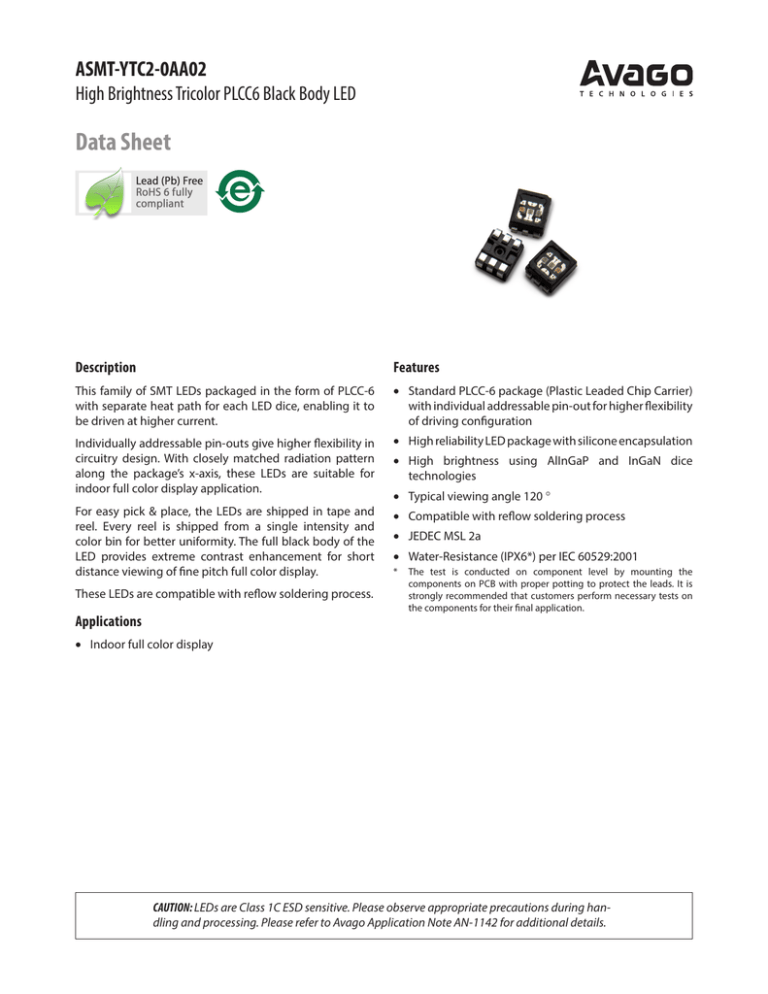
ASMT-YTC2-0AA02
High Brightness Tricolor PLCC6 Black Body LED
Data Sheet
Description
Features
This family of SMT LEDs packaged in the form of PLCC-6
with separate heat path for each LED dice, enabling it to
be driven at higher current.
• Standard PLCC-6 package (Plastic Leaded Chip Carrier)
with individual addressable pin-out for higher flexibility
of driving configuration
Individually addressable pin-outs give higher flexibility in
circuitry design. With closely matched radiation pattern
along the package’s x-axis, these LEDs are suitable for
indoor full color display application.
• High reliability LED package with silicone encapsulation
For easy pick & place, the LEDs are shipped in tape and
reel. Every reel is shipped from a single intensity and
color bin for better uniformity. The full black body of the
LED provides extreme contrast enhancement for short
distance viewing of fine pitch full color display.
• Compatible with reflow soldering process
These LEDs are compatible with reflow soldering process.
Applications
•High brightness using AlInGaP and InGaN dice
technologies
• Typical viewing angle 120 °
• JEDEC MSL 2a
• Water-Resistance (IPX6*) per IEC 60529:2001
* The test is conducted on component level by mounting the
components on PCB with proper potting to protect the leads. It is
strongly recommended that customers perform necessary tests on
the components for their final application.
• Indoor full color display
CAUTION: LEDs are Class 1C ESD sensitive. Please observe appropriate precautions during handling and processing. Please refer to Avago Application Note AN-1142 for additional details.
Package Dimensions
3
5
2
6
1
3.00
0.50
4
2.30
2.80
2.30
3.40
4
1.80
5
0.20
0.90
Lead Configuration
1
Cathode (Blue)
2
Cathode (Green)
3
Cathode (Red)
4
Anode (Red)
5
Anode (Green)
6
Anode (Blue)
Notes:
1. All dimensions are in millimeter (mm).
2. Unless otherwise specified, tolerance is ± 0.20 mm.
3. Encapsulation = silicone
4. Terminal finish = silver plating
2
6
Red
3
2
Green
Blue
1
Table 1. Absolute Maximum Ratings (TJ = 25 °C)
Parameter
Red
Green & Blue
Unit
50
30
mA
100
100
mA
114
mW
DC forward current [1]
Peak forward current [2]
Power dissipation
125
Reverse voltage [3]
4
V
125
°C
Operating temperature range
-40 to + 110
°C
Storage temperature range
-40 to + 120
°C
Junction temperature
Notes:
1. Derate linearly as shown in Figure 7 to Figure 10.
2. Duty Factor = 10% Frequency = 1 kHz
3. Driving the LED in reverse bias condition is suitable for the short term only
Table 2. Optical Characteristics (TJ = 25 °C)
Luminous Intensity,
IV (mcd)
@ IF = 20 mA [1]
Dominant Wavelength,
λd (nm)
@ IF = 20 mA [2]
Peak Wavelength,
λp (nm)
@ IF = 20 mA
Viewing
Angle,
2θ½ (°) [3]
Luminous
Efficacy,
ηV (lm/W)
Luminous
Efficiency,
ηe (lm/W)
Color
Min.
Typ.
Max.
Min.
Typ.
Max.
Typ.
Typ.
Typ.
Typ.
Red
355
450
715
618
622
628
629
120
210
22
Green
450
560
900
525
530
537
521
120
535
25
Blue
140
180
285
465
470
477
464
120
84
5
Notes:
1. Luminous intensity, IV is measured at the mechanical axis of the LED package at a single current pulse condition. The actual peak of the spatial
radiation pattern may not be aligned with the axis.
2. Dominant wavelength is derived from the CIE Chromaticity Diagram and represents the perceived color of the device.
3. θ½ is the off-axis angle where the luminous intensity is ½ of the peak intensity.
4. ΦV is the total luminous flux output as measured with an integrating sphere at mono pulse condition.
Table 3. Electrical Characteristics (TJ = 25 °C)
Forward Voltage, VF (V)
@ IF = 20 mA [1]
Reverse Voltage, VR (V)
@ IR = 100 mA [2]
Reverse Voltage, VR (V)
@ IR = 10 mA [2]
Thermal Resistance,
RθJ-S (°C/W)
Color
Min.
Typ.
Max.
Min.
Min.
1 chip on
Red
1.8
2.1
2.5
4.0
--
280
280
Green
2.8
3.2
3.8
--
4.0
180
230
Blue
2.8
3.2
3.8
--
4.0
180
230
Notes:
1. Tolerance ± 0.1 V.
2. Indicates product final testing condition. Long-term reverse bias is not recommended.
3
3 chips on
Part Numbering System
A
S
M
T
-
Y
T
C
2
-
0
A
x1
A
0
2
x2 x3 x4 x5
Code
Description
Option
x1
x2
Package type
Minimum intensity bin
C
A
x3
x4
Number of intensity bins
Color bin combination
A
0
x5
Test option
2
Black Body
Red: bin T2
Red: bin T2, U1, U2
Green: bin U1
Green: bin U1, U2, V1
Blue: bin R1
Blue: bin R2, S1, S2
3 intensity bins from minimum
Red: full distribution
Green: bin A, B, C
Blue: bin A, B, C, D, E
Test current = 20 mA
Table 4. Bin Information
Intensity Bins (CAT)
Color Bins (BIN) – Red
Bin ID
Min (mcd)
Max (mcd)
R2
140.0
180.0
S1
180.0
224.0
S2
224.0
285.0
T1
285.0
355.0
T2
355.0
450.0
U1
450.0
560.0
U2
560.0
715.0
V1
715.0
900.0
Bin ID
Dominant Wavelength
(nm)
Min.
Max.
Chromaticity coordinate
(for reference)
Cx
Cy
--
618.0
0.6873
0.6696
0.6866
0.7052
Color Bins (BIN) – Blue
Color Bins (BIN) – Green
Bin ID
Dominant Wavelength
(nm)
Min.
Max.
Chromaticity Coordinate
(for reference)
Cx
Cy
A
525.0
0.1142
0.1799
0.2138
0.1625
0.1387
0.1971
0.2298
0.1854
0.1625
0.2138
0.2454
0.2077
B
C
528.0
531.0
534.0
537.0
0.8262
0.6783
0.6609
0.8012
0.8148
0.6703
0.6507
0.7867
0.8012
0.6609
0.6397
0.7711
Bin ID
Dominant Wavelength
(nm)
Min.
Max.
Chromaticity coordinate
(for reference)
Cx
Cy
A
465.0
469.0
B
467.0
471.0
C
469.0
473.0
D
471.0
475.0
E
473.0
477.0
0.1355
0.1751
0.1680
0.1267
0.1314
0.1718
0.1638
0.1215
0.1267
0.1680
0.1593
0.1158
0.1215
0.1638
0.1543
0.1096
0.1158
0.1593
0.1489
0.1028
Tolerance: ±1 nm
Tolerance: ±1 nm
4
0.3126
0.3136
0.2967
0.2948
Tolerance: ±1 nm
Tolerance: ±12%
531.0
628.0
0.0399
0.0986
0.1094
0.0534
0.0459
0.1034
0.1167
0.0626
0.0534
0.1094
0.1255
0.0736
0.0626
0.1167
0.1361
0.0868
0.0736
0.1255
0.1490
0.1029
Characteristics
100
1.0
Green
Blue
Red
FORWARD CURRENT-mA
RELATIVE INTENSITY
0.8
0.6
0.4
0.2
0.0
380
480
580
WAVELENGTH - nm
DOMINANT WAVELENGTH SHIFT - nm
Red
Blue
Green
0
20
20
0
1
2
3
FORWARD VOLTAGE-V
4
5
Figure 5. Relative Luminous Intensity vs. Junction Temperature
-2
-4
-6
Red
Green
Blue
-8
120
20
100
0.3
1
0
20
40
60
80 100
TJ - JUNCTION TEMPERATURE - °C
0
40
60
80
FORWARD CURRENT - mA
Figure 4. Dominant Wavelength Shift vs. Forward Current
Red
Green
Blue
-20
2
-10
0
100
FORWARD VOLTAGE SHIFT- V
RELATIVE LUMINOUS INTENSITY
(NORMALIZED AT 20mA)
RELATIVE INTENSITY
40
4
10
5
Blue /
Green
Figure 2. Forward Current vs. Forward Voltage
40
60
80
DC FORWARD CURRENT-mA
Figure 3. Relative Luminous Intensity vs. Forward Current
0.1
-40
Red
60
0
680
Figure 1. Relative Spectral Emission
5.0
4.5
4.0
3.5
3.0
2.5
2.0
1.5
1.0
0.5
0.0
80
140
120
Red
Green
Blue
0.2
0.1
0
-0.1
-0.2
-0.3
-0.4
-40
-20
0
20
40
60
80 100
TJ - JUNCTION TEMPERATURE - °C
Figure 6. Forward Voltage Shift vs. Junction Temperature
120
140
60
MAXIMUM FORWARD CURRENT - mA
MAXIMUM FORWARD CURRENT - mA
60
50
TS
40
TA
30
20
10
0
0
20
40
60
80
TEMPERATURE - °C
100
20
10
0
20
40
60
80
TEMPERATURE - °C
TS
30
TA
20
10
0
20
40
60
80
TEMPERATURE - °C
100
120
120
TS
30
TA
20
10
0
0
20
40
60
80
TEMPERATURE - °C
100
120
Figure 10. Maximum Forward Current vs. Temperature for Green & Blue
(3 chips on)
Figure 9. Maximum Forward Current vs. Temperature for Green & Blue
(1 chip on)
Note:
Maximum forward current graphs based on ambient temperature, TA are with reference to thermal resistance RθJ-A below.
For more details, see Precautionary Notes (4).
Thermal resistance from LED junction to ambient, RθJ-A (°C/W)
Condition
Red
Green & Blue
1 chip on
473
373
3 chips on
563
563
6
100
40
MAXIMUM FORWARD CURRENT - mA
MAXIMUM FORWARD CURRENT - mA
TA
30
Figure 8. Maximum Forward Current vs. Temperature for Red (3 chips on)
40
0
TS
40
0
120
Figure 7. Maximum Forward Current vs. Temperature for Red (1 chip on)
50
1
0.8
0.8
NORMALIZED INTENSITY
NORMALIZED INTENSITY
1.0
0.6
0.4
Red
Green
Blue
0.2
0.0
-90
-60
-30
0
30
ANGULAR DISPLACEMENT - DEGREE
60
0.6
0.4
0
-90
90
Red
Green
Blue
0.2
-60
-30
Figure 11b. Radiation pattern along y-axis of the package
Y
X
Y
Figure 11c. Illustration of package axis for radiation pattern
2.30
0.50
4.55
1.35
1.60
Maximize the size of copper pad of PIN 1, PIN 4, PIN5
for better heat dissipation.
0.40
Figure 12. Recommended soldering land pattern
7
30
ANGULAR DISPLACEMENT - DEGREE
Figure 11a. Radiation pattern along x-axis of the package
X
0
Copper pad
Solder mask
60
90
4.00 ±0.10
4.00 ±0.10
2.00 ±0.05
+0.10
∅ 1.50 0
Package Marking
1.75 ±0.10
3.50 ±0.05
2.29 ±0.10
+0.30
8.00 -0.10
+0.10
∅ 1.00 0
3.05 ±0.10
3.81 ±0.10
0.229 ±0.01
Figure 13. Carrier tape dimensions
USER FEED DIRECTION
PACKAGE MARKING
PRINTED LABEL
Figure 14. Reeling Orientation
8.0 ± 1.0 (0.315 ± 0.039)
10.50 ± 1.0 (0.413 ± 0.039)
13.1 ± 0.5
Ø (0.516 ± 0.020)
20.20 MIN.
Ø (0.795 MIN.)
3.0 ± 0.5
(0.118 ± 0.020)
59.60 ± 1.00
(2.346 ± 0.039)
178.40 ± 1.00
(7.024 ± 0.039)
4.0 ± 0.5
(0.157 ± 0.020)
Figure 15. Reel dimensions
8
6
PS
5.0 ± 0.5
(0.197 ± 0.020)
Packing Label
(i) Standard label (attached on moisture barrier bag)
(1P) Item: Part Number
STANDARD LABEL LS0002
RoHS Compliant Halogen Free
e4 Max Temp 260C MSL2a
(1T) Lot: Lot Number
(Q) QTY: Quantity
LPN:
CAT: Intensity Bin
(9D)MFG Date: Manufacturing Date
BIN: Color Bin
(P) Customer Item:
(9D) Date Code: Date Code
(V) Vendor ID:
DeptID:
Made In: Country of Origin
(ii) Baby label (attached on plastic reel)
(1P) PART #: Part Number
BABY LABEL COSB001B V0.0
(1T) LOT #: Lot Number
(9D)MFG DATE: Manufacturing Date
QUANTITY: Packing Quantity
C/O: Country of Origin
(9D): DATE CODE:
(1T) TAPE DATE:
D/C: Date Code
CAT: INTENSITY BIN
BIN: COLOR BIN
Example of luminous intensity (Iv) bin information on label:
CAT: T2 U1 R1
Intensity for Blue: R1
Intensity for Green: U1
Intensity for Red: T2
Example of color bin information on label:
BIN: A B
Color Bin for Blue: B
Color Bin for Green: A
Note: There is no color bin ID for Red color as there is only 1 range ,as stated in Table 4.
9
VF:
Soldering
Recommended reflow soldering condition:
(i) Leaded reflow soldering:
(ii) Lead-free reflow soldering:
20 SEC. MAX.
183°C
100-150°C
-6°C/SEC.
MAX.
3°C/SEC.
MAX.
120 SEC. MAX.
60-150 SEC.
TIME
a. Reflow soldering must not be done more than 2 times.
Make sure the necessary precautions are observed for
handling moisture-sensitive device as stated in the
following section.
b. Recommended board reflow direction:
TEMPERATURE
TEMPERATURE
10 to 30 SEC.
240°C MAX.
3°C/SEC. MAX.
217°C
200°C
255 - 260 °C
3°C/SEC. MAX.
6°C/SEC. MAX.
150°C
3 °C/SEC. MAX.
100 SEC. MAX.
60 - 120 SEC.
TIME
c. Do not apply any pressure or force on the LED during
reflow and after reflow when the LED is still hot.
d. It is preferred to use reflow soldering to solder the LED.
Use hand soldering for rework if this is unavoidable,
but it must be strictly controlled to the following
conditions:
- Soldering iron tip temperature = 320 °C max
- Soldering duration = 3 sec max
- Number of cycles = 1 only
- Power of soldering iron = 50 W max
e. Do not touch the LED body with hot soldering iron
except the soldering terminals as it may cause damage
to the LED.
f. For de-soldering, it is recommended that you use a
double flat tip.
g. You are advised to confirm beforehand whether hand
soldering will affect the functionality and performance
of the LED.
REFLOW DIRECTION
10
PRECAUTIONARY NOTES
1. Handling precautions
2. Handling of moisture-sensitive device
The encapsulation material of the LED is made of silicone
for better product reliability. Compared to epoxy encapsulant, whichis hard and brittle, silicone is softer and
flexible. Special handling precautions must be taken
during assembly of silicone encapsulated LED products.
Failure to comply might lead to damage and premature
failure of the LED. For more information. refer to Application Note AN5288, Silicone Encapsulation for LED: Advantages and Handling Precautions.
This product has a Moisture Sensitive Level 2a rating per
JEDEC J-STD-020. For additional details and a review of
proper handling procedures, refer to Avago Application
Note AN5305, Handling of Moisture Sensitive Surface Mount
Devices.
a. Before use
- An unopened moisture barrier bag (MBB) can be
stored at < 40 °C/90% RH for 12 months. If the actual
shelf life has exceeded 12 months and the Humidity
Indicator Card (HIC) indicates that baking is not
required, then it is safe to reflow the LEDs per the
original MSL rating.
a. Do not poke sharp objects into the silicone encapsulant.
Sharp objects such as tweezers or syringes might exert
excessive force or even pierce through the silicone and
induce failures in the LED die or wire bond.
b. Do not touch the silicone encapsulant. Uncontrolled
force acting on the silicone encapsulant might result in
excessive stress on the wire bond. Hold the LED only by
its body.
- It is recommended that the MBB not be opened
before assembly (e.g., for IQC).
b. Control after opening the MBB
- The HIC shall be read immediately upon opening of
the MBB.
c.Do no stack assembled PCBs together. Use an
appropriate rack to hold the PCBs.
d.The surface of silicone materials attracts more dust
and dirt than to epoxy, due to its surface tackiness. To
remove foreign particles on the surface of silicone, a
cotton bud can be used with isopropyl alcohol (IPA).
During cleaning, rub the surface gently without putting
much pressure on the silicone. Ultrasonic cleaning is
not recommended.
e. For automated pick and place, Avago has tested that the
following nozzle size works fine with this LED. However,
due to possible variations in other parameters such
as pick and place machine maker/model and other
settings of the machine, it is recommended that you
verify that the nozzle selected will not cause damage
to the LED.
- The LEDs must be kept at < 30 °C/60% RH at all
times and all high temperature related processes
including soldering, curing or rework need to be
completed within 672 hours.
c. Control for unfinished reel
- Unused LEDs must be stored in a sealed MBB with
desiccant or desiccator at < 5% RH.
d. Control of assembled boards
- If the PCB soldered with the LEDs is to be subjected
to other high temperature processes, the PCB
must be stored in a sealed MBB with desiccant or
desiccator at < 5% RH to ensure that all LEDs have
not exceeded their floor life of 672 hours.
e. Baking is required if:
- The HIC indicator is not BROWN at 10% and is AZURE
at 5%.
- The LEDs are exposed to a condition of >30 °C / 60%
RH at any time.
- The LED floor life exceeded 672 hrs.
ID
OD
ID = 1.7mm
OD = 3.5mm
11
The recommended baking condition is: 60 ± 5 °C for 20
hrs. Baking should only be done once.
f.Storage
- The soldering terminals of these Avago LEDs are
silver plated. If the LEDs are exposed in an ambient
environment for too long, the silver plating
might be oxidized and thus affect its solderability
performance. As such, unused LEDs must be kept in
a sealed MBB with desiccant or in desiccator at < 5%
RH.
3. Application precautions
a.Drive current of the LED must not exceed the
maximum allowable limit across temperature as
stated in the datasheet. Constant current driving is
recommended to ensure consistent performance.
The complication of using this formula lies in TA and
RqJ-A. Actual TA is sometimes subjective and hard to determine. RqJ-A varies from system to system depending
on design and is usually not known.
b. LED is not intended for reverse bias. Do use other
appropriate components for such purpose. When
driving the LED in matrix form, it is crucial to ensure
that the reverse bias voltage is not exceeding the
allowable limit of the LED.
Another way of calculating TJ is by using solder point
temperature TS as shown below:
c. Do not use the LED in the vicinity of material with
sulfur content, in environment of high gaseous
sulfur compound and corrosive elements. Examples
of material that may contain sulfur are rubber gasket,
RTV (room temperature vulcanizing) silicone rubber,
rubber gloves etc. Prolonged exposure to such
environment may affect the optical characteristics
and product life.
TJ = TS + RqJ-S x IF x VFmax
where;
TS = LED solder point temperature as shown in illustration below [°C]
RqJ-S = thermal resistance from junction to solder point
[°C/W]
d.Avoid rapid change in ambient temperature
especially in high humidity environment as this will
cause condensation on the LED.
e.Although the LED is rated as IPx6 according to
IEC60529: Degree of protection provided by
enclosure, the test condition may not represent
actual exposure during application. If the LED
is intended to be used in outdoor or harsh
environment, the LED must be protected against
damages caused by rain water, dust, oil, corrosive
gases, external mechanical stress etc.
4. Thermal management
Optical, electrical and reliability characteristics of LED
are affected by temperature. The junction temperature
(TJ ) of the LED must be kept below allowable limit at all
times. TJ can be calculated as below:
TJ = TA + RqJ-A x IF x VFmax
where;
TA = ambient temperature [°C]
RqJ-A = thermal resistance from LED junction to ambient
[°C/W]
IF = forward current [A]
VFmax = maximum forward voltage [V]
Ts point - pin 5
TS can be measured easily by mounting a thermocouple on the soldering joint as shown in illustration above,
while RqJ-S is provided in the datasheet. User is advised
to verify the TS of the LED in the final product to ensure
that the LEDs are operated within all maximum ratings
stated in the datasheet.
5. Eye safety precautions
LEDs may pose optical hazards when in operation. It is
not advisable to view directly at operating LEDs as it
may be harmful to the eyes. For safety reasons, use appropriate shielding or personal protective equipments.
6.Disclaimer
Avago’s products are not specifically designed, manufactured or authorized for sale as parts, components
or assemblies for the planning, construction, maintenance or direct operation of a nuclear facility or for
use in medical devices or applications. Customer is
solely responsible, and waives all rights to make claims
against Avago or its suppliers, for all loss, damage,
expense or liability in connection with such use.
DISCLAIMER: Avago’s products and software are not specifically designed, manufactured or authorized for sale
as parts, components or assemblies for the planning, construction, maintenenace or direct operation of a
nuclear facility or for use in medical devices or applications. Customer is solely responsible, and waives all rights to
make claims against avago or its suppliers, for all loss, damage, expense or liability in connection with such use.
For product information and a complete list of distributors, please go to our web site: www.avagotech.com
Avago Technologies, and the A logo are trademarks of Avago Technologies in the United States and other countries.
Data subject to change. Copyright © 2005-2015 Avago Technologies. All rights reserved.
AV02-2589EN - October 15, 2015

